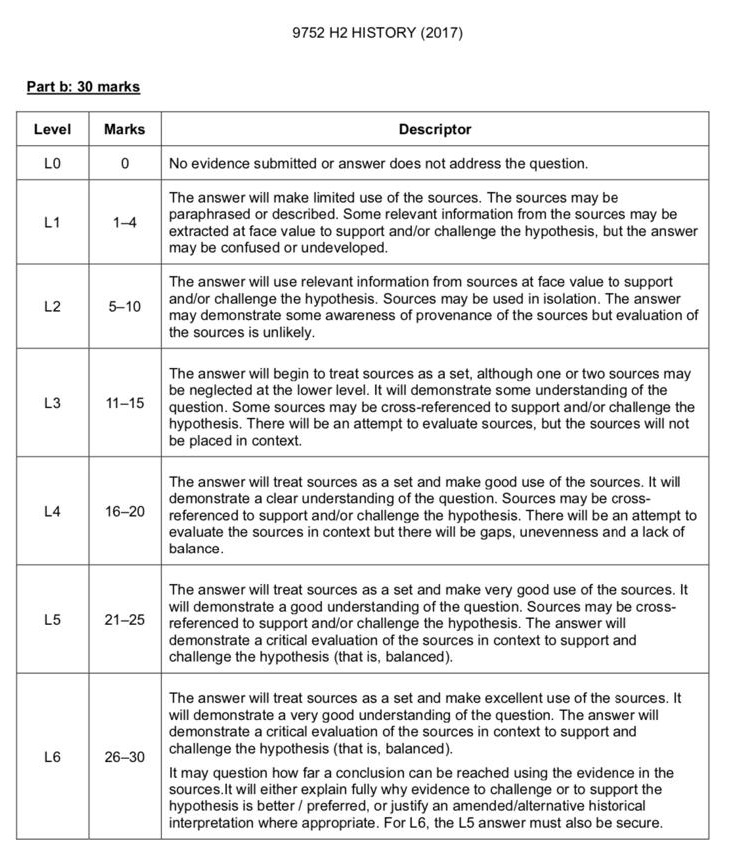The A Levels History Source Based Questions Levels of Responses
Students are often befuddled by the A Levels History Source Based Questions, (SBQ) especially for the dreaded 30-marks Part B. No doubt, it is indeed challenging, given the seemingly unachievable Levels of Responses expected of students. Achieving the L6 level in their responses seems like an impossible dream: something of a fantasy, something that cannot be done, something that is their white whale.
For some context, in a nutshell, students are expected to do a few steps: analyse each and every source, break down their messages and individual reliability, group the messages together, and synthesise the given information to create a coherent historical narrative based on the viability of the sources.
Assessing the Levels of Responses Marking Scheme (LORMS) should already point out a few things: “treat sources as a set and make excellent use of the sources”, “demonstrate a very good understanding of the question”, and “question how far a conclusion could be reached using the evidence in the source”.
This seems all well and good until students are actually required to create pieces of writing that seemingly conform with these notions. At this juncture, they may begin questioning: What? How? Why?
Analysing the message of a source is quite simple. As discussed in a previous post, improving source-based questions is actually dependent on one’s grasp of vocabulary and knowledge of the meaning of symbols. Taking our answers beyond the basic Source-A-supports,-Source-B-challenges writing requires something a little deeper. Yet, at the same time, some steps are so simple that students strangely miss them out through the course of their writing.
Deep breaths. If something seems overwhelming, let us take it step-by-step. In truth, H2 History Source Based Questions can be difficult, but once you get the grasp of it, it becomes more tedious than difficult. That being said, that does not mean that we cannot be organised.
To keep things simple, we but only have to follow this checklist that breaks down the markers of well-written history source based questions answers.

Check 1: I explicitly grouped sources based on their overall message.
When the LORMS demands a grouping of sources, simply ask yourself if you explicitly grouped them. In your history source based questions, there are always two big sets of sources: one that supports the question’s assertions and one that challenges the question’s assertions.
Indicating the sources and under which group they subsume is the first step. This can be easily achieved by stating explicitly within the opening sentence of your paragraph which sources support or challenge the question’s assertion.
[su_box title=”Right Example”]
Sources A, B and C similarly supports/challenges the question by asserting [overall reason for their supporting the question’s assertion]
[/su_box]
[su_box title=”Wrong Example”]
Source A challenges the question. In Source A, it is stated…
Source B challenges the question. In Source B, …
[/su_box]
Check 2: I explicitly cross-referenced sources based on their overall message.
Explicitly grouping the sources is not enough. You need to justify – based on the evidence presented within the source – why the sources may support one another in their respective messages. This can be easily done by explaining the similarities in the messages of the sources.
[su_box title=”Right Example”]
In Source A, [whoever] stated that “[source’s message]”. This suggests [explanation]. This notion is further supported by Source B, where it is asserted that “[source B’s message]”, suggesting [explanation of Source B]. This is similar to what [whoever] stated in Source A, where [overall reason for their supporting the question’s assertion].
[/su_box]
[su_box title=”Wrong Example”]
In Source A, [whoever] stated that “[source A’s message]”. This suggests [explanation]. Source B asserted that “[source B’s message]”, suggesting [explanation of Source B].
[/su_box]
In the wrong example above, there is no clear indication that the sources’ messages are cross-referenced to one another. This seems obvious, but it can be easily overlooked in the heat of exams pressure.
The aforementioned two steps – Checks 1 and 2 – should be done within a single body paragraph for a single set of sources, i.e. 1 paragraph for support sources and 1 paragraph for challenge sources. Of course, for example, if you had 4 sources that supported the question’s assertion, you can split the explanations into two paragraphs for the sake of maintaining tidiness.
Using the hypothetical examples above, it should look something like this:
[su_box title=”Example”]
Sources A, B and C similarly supports/challenges the question by asserting [overall reason for their supporting the question’s assertion](Check 1) In Source A, [whoever] stated that “[source A’s message]”. This suggests [explanation]. This notion is further supported by Source B, where it is asserted that “[source B’s message]”, suggesting [explanation of Source B]. This is similar to what [whoever] stated in Source A, where [overall reason for their supporting the question’s assertion]. Furthermore, in Source C, it is stated that “[source C’s message]”, which suggests that [explanation]. Source C’s message supports Sources A and B in [explain similarities].
[/su_box]
This is just an example. The nuances of the actual writing differ between 1. The given question 2. The given sources. At this juncture, if you have done this for BOTH the support and challenge sets of sources, you should achieve – at most – L2. [5-10 marks]
While this seems like a paltry amount of marks, you can essentially achieve this by writing two paragraphs. (~10 mins of writing) From this point onwards, this is where it gets trickier to achieve higher levels of responses, but it may not necessarily be more difficult.
Check 3: I explicitly grouped the sources based on their overall reliability.
Similar to Check 1, as you begin an in-depth analysis of your sources, you should signpost your analysis with an assertion of the overall viability of the set of sources.
For instance, let’s say we have Sources A, B and C that support the question’s assertion and – upon individual analysis – they were all unreliable and not useful. You should then point out explicitly that this is the case.
[su_box title=”Right Example”]
Sources A, B and C provide a weak support for the question’s assertion given their weak reliability and usefulness.
[/su_box]
[su_box title=”Wrong Example”]
Beginning your paragraph with Source A is unreliable. It is published in … Source B is unreliable. It is published…
[/su_box]
In this case, the wrong example demonstrates piecemeal analysis, which directly runs contrary against what is expected of you.
Of course, this is but a mere signpost, but as I said, we are literally taking this step-by-step. These following checks are concomitant to this one.

Check 4: I explicitly cross-referenced the sources and analysed whether or not the sources elevate one another within the same set.
Sources may be weak individually, but should they be cross-referenced with a strong source, they may possibly be elevated. One such example can be seen below. There are other possible permutations, but we delve into detail here.
[su_box title=”Example”]
Source A is a source [explain provenance, place the source in context, justify purpose]. As such, it is an unreliable source. However, when placed together with Source B, the source’s reliability is enhanced on the basis of a corroboration. Source B is [explain provenance, place the source in context, justify purpose]. It is thus a reliable source. Given that it echoes similar sentiments with Source A, the viability and credibility of Source A is elevated as a result.
[/su_box]
What students commonly do is that they simply analyse the sources one by one without considerations of the set as a whole. As the saying goes, “more than the sum of its parts”; if the sources within the same set are corroborated by a reliable one, the set is enhanced as a whole.
Check 5: I explicitly assessed the usefulness of the set of sources.
Utility or usefulness analysis is one thing by which many students are confused. To put it simply, usefulness refers to the different perspectives that it adopts that can be used to construct a coherent historical narrative.
Generally speaking, in history source based questions, I would recommend students do a utility assessment of the set of sources as a whole; otherwise, individual analyses may be too long and cumbersome. This analysis should book-end the paragraph on the analysis of the reliability of sources. An example can be seen below:
[su_box title=”Example”]
[Analyse individual sources’ reliability, assess the overall reliability] A deeper analysis of Sources A, B and C highlight that the support/challenge set is useful in providing a multi-perspective analysis in supporting/challenging the question’s thesis. Source A provides [perspective A], while Source B provides [perspective B] and Source C provides [perspective C].
[/su_box]
This is but an example. There are, again, many other possible permutations, such as two sources providing the same perspective with the exception of the third, or – more commonly – all sources in that set provides the same perspective.
Nevertheless, this is a necessary step to take. Assuming that your analyses of the sources are accurate – i.e., justified purposes, placed in context, overall reliability AND overall usefulness, etc. – completing Checks 3-5 for BOTH the support and challenge sets should net you an L4. [16-20]
I cannot emphasise enough how important it is to ensure that the analyses are accurate. We will go through in greater detail in another post.
However, at this point, this is the threshold most students who may need help (which we offer with our h2 history tuition) struggle to break through. Indeed, what must be done to break the L5/L6 range?
Check 6: I stated explicitly which set of sources is preferred/
Once you have fleshed out the sources of both the support and challenge sets, it is now time to compare between the two.
There are different scenarios for this. Either one set is strongly preferred over the other, or both sets are needed to create a nuanced, historical narrative, or both sets leave something to be desired. (Rarely do you see the last one occurring; nevertheless, one must be ready to deal with such scenarios.)
Either way, you can point out which scenario you are opting for explicitly in your writing. For the sake of explanation, let’s say we have one set that is very clearly preferred over the other. Such an example can be seen below.
[su_box title=”Example”]
In conclusion, this essay would assert that the support set is preferred over the challenge set of sources. [Briefly summarise the reasons why; i.e., the support set has reliable sources as opposed to the challenge set, the support set is more useful, etc.]
[/su_box]
Once you have done this, immediately move on to Check 7.
Check 7: I cross-referenced sources between the “support” and “challenge” sets of sources.
Let’s say that we are in the same hypothetical scenario where we have one set that is very clearly preferred over the other on the bases that 1. The set is reliable as a whole 2. The set provides multiple perspectives in answering the question.
What you could do is to use a reliable source from the preferred set to undermine the weak source on the other set that has a similar message. An example of such writing could be seen below:
[su_box title=”Example”]
Furthermore, cross-referencing Source A with Source D reveal that Source A undermines Source D, on the basis that Source A is a more credible source that directly refutes the assertion put forth by Source D. Source D, on the other hand, as analysed above, is an unreliable source due to [brief reasons why Source D is unreliable]. Resultantly, what was stated in Source D – [quote] – can be categorically denied in favour of Source A.
[/su_box]
How you cross-refer sources between sets is highly dependent on the sources that are available to you. Exposure to different types of history source based questions will help tremendously in helping you understand 1. The construction of nuanced sets of sources 2. How they fare against one another OR how they may actually NEED one another.
Achieving this step will bump your answer up to an L5. [21-25]
Check 8: I produced a new hypothesis that explicitly sharpens the question’s thesis.
The last step is a step that only requires one sentence to achieve. However, in reality, this step cannot be justified without first fulfilling all the previous checks.
This step, in essence, is the culmination of your answer. Any missteps in the previous checks would drastically alter the answer that is produced in this step; in the event that the answer does not accurately capture the assessment of the given sources, even if this step is fulfilled, credit may not be given.
That being said, there are, again, a few possible scenarios; these scenarios are dependent on the previous step. Assuming that we have a scenario where both sets of sources are needed, an example of how you should write your altered hypothesis should be something like this:
[su_box title=”Example”]
As such, the question’s hypothesis should be amended as such: the Cold War was caused by the Soviet Union and USA misinterpreting each other’s foreign policies. Sole blame should not be placed on the USSR for causing the Cold War.
[/su_box]
Again, this is but an example. The way you write your hypotheses is still dependent entirely on the given sources and question.
Yes, this is a lengthy post, but if you are facing difficulty in attaining higher levels of responses in your history source based questions part B, this rudimentary checklist may serve to enlighten you further.
That’s it. These are the checks that you should always do when tackling your H2 History source based questions. All the best, and good luck for your studies. Should you have any questions, please do not hesitate to Contact Us. We offer H2 History Tuition lessons that go more into the granular details of writing history source based questions’ responses. If you are interested, we offer FREE trial lessons as well! (especially for history source based questions
If you would like to have an example of a full suggested answer, please join our Telegram Channel and drop me a message!
[su_button url=”https://t.me/thediscourseeducation” target=”blank”]Join Our Telegram Channel![/su_button]
Featured image by Glenn Carstens-Peters on Unsplash

